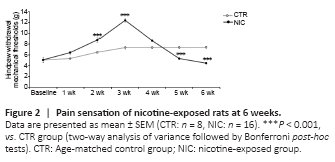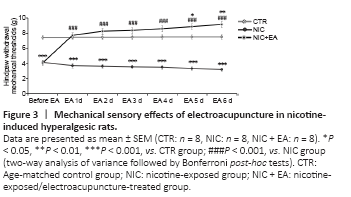神经损伤与修复
-
Figure 1|The location of the acupoints Zusanli (ST36) and Taichong (LR3) in rats.

According to the mechanical sensory behavioral testing, after 6 weeks of continuous nicotine exposure, all the nicotine-induced hyperalgesic rats in the NIC + EA group received electroacupuncture at bilateral Zusanli and Taichong acupoints. The comparative anatomy was used to locate the rat acupoints (Guo and Fang, 2008). As shown in Figure 1.
Figure 2|Pain sensation of nicotine-exposed rats at 6 weeks.

Behavioral testing results in the NIC (n = 16) and CTR (n = 8) groups of rats were evaluated during the 6 weeks of nicotine exposure. Figure 2 shows the differences of pain sensation in the NIC and CTR groups at 6 weeks. Mechanical thresholds in the NIC group gradually increased during the nicotine exposure period of weeks 1–3 and were significantly higher in weeks 2–3 compared to the CTR group (P < 0.001), indicating an expected initial analgesic effect. In the fourth week of nicotine exposure, the mechanical thresholds in the NIC group decreased but were still higher compared to the CTR group (P > 0.05). In the nicotine exposure period of weeks 5–6, the mechanical thresholds in the NIC group continued to decrease and were significantly lower compared to the CTR group (P < 0.001), indicating hyperalgesia from long-term nicotine exposure. The results indicate that short-term acute nicotine exposure produced an analgesic effect, and long-term chronic nicotine exposure led to an increase in pain sensitivity.
Figure 3|Mechanical sensory effects of electroacupuncture in nicotine-induced hyperalgesic rats.

Behavioral testing results in the CTR (n = 8), NIC (n = 8) and NIC + EA (n = 8) groups of rats were evaluated during the 6-day period of electroacupuncture treatment. Twenty-four hours after each electroacupuncture treatment, mechanical sensory behavioral testing was performed in all three groups of rats. Figure 3 shows the differences of pain sensation in the three groups during the 6-day period of electroacupuncture treatment. The NIC group consistently demonstrated lower mechanical thresholds compared to the CTR group indicating hyperalgesia (P < 0.001). After electroacupuncture treatments, the mechanical thresholds increased in the nicotine exposed rats and were significantly higher than those in the NIC group without electroacupuncture (P < 0.001). After the fifth and the sixth electroacupuncture treatment, the mechanical thresholds were significantly higher in the nicotine exposed rats than even those in the CTR group (P < 0.05 or 0.01). The results indicate that electroacupuncture treatment had positive analgesic effects on pain sensitivity in the nicotine exposed rats. This analgesic effect was maintained for at least 24 hours after each electroacupuncture treatment.
Figure 4|Electroacupuncture effects on MOR, β-EP, GAD67, and GAD65 protein expression in the spinal cord of nicotine-induced hyperalgesic rats.

MOR, β-EP, GAD67, and GAD65 protein expression in the spinal cord and PAG of the CTR (n = 6), NIC (n = 6) and NIC + EA (n = 6) groups of rats were analyzed by western blotting assay after the 6-day period of electroacupuncture treatment. Figure 4 shows the differences in MOR, β-EP, GAD67, and GAD65 protein expression in the spinal cord of rats in the three groups after the 6-day period of electroacupuncture treatment. In the NIC group, MOR, β-EP, GAD67, and GAD65 protein expression in the spinal cord were significantly lower compared to those in the CTR group (P < 0.05 or 0.01). After electroacupuncture treatments, MOR, β-EP, GAD67, and GAD65 protein expression in the spinal cord increased in the nicotine exposed rats and were significantly higher than those in the NIC group without electroacupuncture (P < 0.05 or 0.001). The protein expression of GAD65 in the spinal cord in the NIC + EA group was significantly higher than that in the CTR group (P < 0.05). The results indicate that MOR, β-EP, GAD67, and GAD65 protein expression in the spinal cord were significantly increased by electroacupuncture treatment in the nicotine-induced hyperalgesic rats.
Figure 5|Electroacupuncture effects on MOR, β-EP, GAD67, and GAD65 protein expression in the PAG of nicotine-induced hyperalgesic rats.

Figure 5 shows the differences of MOR, β-EP, GAD67, and GAD65 protein expression in the PAG of the three groups of rats. In the NIC group, MOR and GAD65 protein expression in the PAG were significantly lower than those in the CTR group (P < 0.05). There were no significant differences in the protein expression of β-EP or GAD67 in the PAG in the NIC group compared to the CTR group (P > 0.05). After electroacupuncture treatment, MOR, β-EP, and GAD65 protein expression in the PAG increased in the nicotine exposed rats and were significantly higher than those in the NIC group without electroacupuncture (P < 0.05 or 0.01). There was no significant difference in the protein expression of GAD67 in the PAG between NIC + EA and NIC groups (P > 0.05), and the protein expression of β-EP in the PAG in the NIC + EA group was significantly higher than that in the CTR group (P < 0.01). The results indicate that MOR, β-EP, and GAD65 protein expression in the PAG could be significantly increased by electroacupuncture treatment in nicotine-induced hyperalgesic rats. The electroacupuncture effect on the protein expression of GAD67 in the PAG in nicotine-induced hyperalgesic rats was not significantly changed.